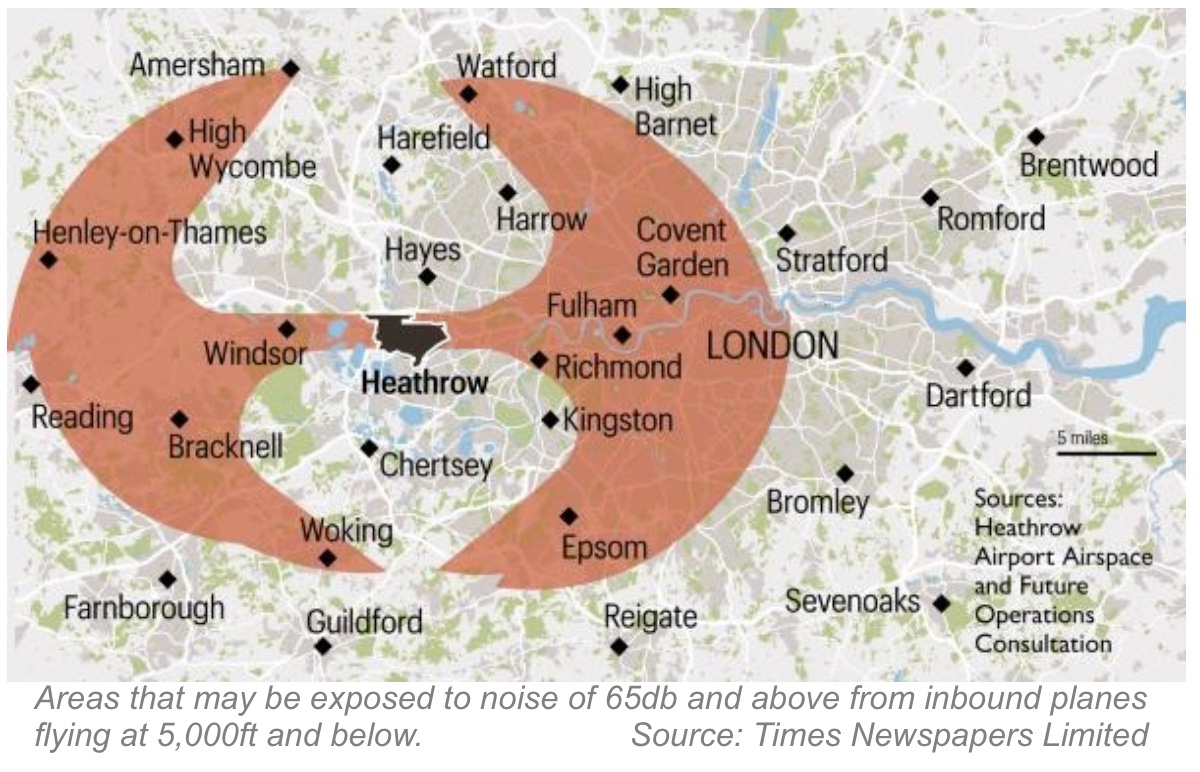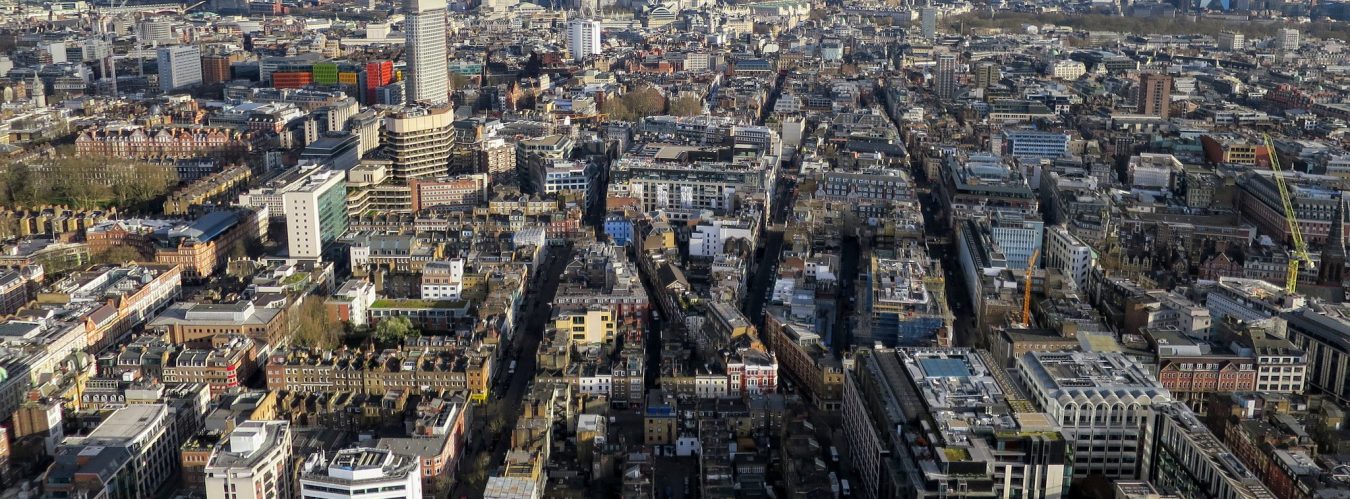The WECN was shocked by what was revealed in the Consultation exhibition held in January 2019. Having been aware of the Government’s consultation on the Airports National Policy Statement, we were under the impression that most of the West End would not be significantly and directly affected by air pollution and noise.
For example, none of the Government’s noise contour maps show the West End as potentially being affected by noise. However, we now see that the Government’s consultation was misleading and the area could indeed be subject to significant noise and air pollution impacts from the expansion of Heathrow. This is well illustrated in the comment piece “Grayling’s expansion plan for Heathrow is a ‘giant con’” by Jon Ungoed-Thomas published in the Sunday Times on 3 March 2019. The image in that report (reproduced below) clearly shows why those of us who live in the West End are very concerned by these proposals.

Had residents, businesses and amenity groups known that the West End would be subject to significant air pollution and noise impacts as a result of the Policy Statement, they would have objected strongly. That these groups are only now being informed of the true impact of the expansion Heathrow Airport is unacceptable.
The WECN are of the view that there should be no further action on a proposal for expanded operations at Heathrow without a fuller consultation with all those potentially affected.
In terms of the information presented in this Consultation, WECN offers the following feedback.
1 Airspace design
1.1 WECN does not consider that there should be any expansion of Heathrow Airport. The environmental damage, especially in terms of air pollution, greenhouse gas emissions and noise that would be caused is unacceptable. Intensification and market forces do not shape place; they destroy place. Intensification cannot continue indefinitely. There is an ultimate capacity – a point in the process of intensification of use where it starts to harm all the things we enjoy. WECN remains particularly concerned that this proposal demonstrates the effects of over-development of Heathrow Airport to the extent that cumulative impacts on Central London cannot be shown to be manageable without unmanageable harmful environmental impact.
1.2 The West End is likely to be badly affected by the proposal to expand Heathrow by adopting ‘Independent Parallel Approaches’ (IPA). We object strongly to the possibility that the area is likely to be particularly affected by the A1, A2, D2 and I1 scenarios for frequency of flights directly overhead at low altitudes. It is unacceptable that residents and others weren’t told that this would be the impact of the expansion of Heathrow.
1.3 There should be no change to the existing flight paths for a 2-runway Heathrow Airport, which at least provides some respite to members of the public. The West End is currently affected by the latest and earliest flights and its residents sometimes have only three or four hours respite overnight. The IP1 scenario will result in many more overflights in the early morning (night period), which will worsen the current noise climate.
1.4 The West End is a particularly sensitive area for air pollution and noise, and is shown as being within the direct lines of low altitude flight paths in IPA design envelopes A1, A2, D2 and I1. While the area has a strong commercial heart, it also includes a number of other sensitive uses including government and embassy uses, hospitals, schools, museums and tourist attractions. Many of these uses are accommodated in historic buildings and cannot adequately mitigate noise to reasonable levels in line with WHO guidance. Listed, single-glazed buildings are at a particular disadvantage in this respect. The cost of mitigation measures would be sought where applicable, but where that cannot apply, financial compensation would be expected. Property values in areas owned by the great estates such as the Crown, Grosvenor, Cavendish, Howard de Walden, Portman, Bedford, etc will be greater so compensation can be expected to be proportionately higher. Can the cost benefit of this proposal be justified in any reasonable and holistic assessment?
1.5 There is also a high density of sensitive locations such as conservation areas, Metropolitan Open Land, registered parks and gardens and world-renowned cultural, educational, healthcare and religious sites including, amongst others, Great Ormond Street Children’s Hospital, the Royal Opera House, British Museum and University of London. There is also Oxford Street, Regent Street and Bond Street, London’s foremost shopping streets. It is extremely important that these places are not significantly affected as they play a key role in London’s society and its economy. Furthermore, the Royal Parks are key areas of freely accessible open space on the edge of the West End that provide for public leisure and recreation. They are the ‘green lungs’ of the city and impacts from aircraft air pollution and nuisance noise on these areas of open space cannot be mitigated in any way. They should be minimised and not increased.
1.6 The West End around Oxford Street is home to more than 70,000 residents and many hotels, has around 650,000 mostly daytime workers, the largest number of theatres anywhere in the UK, houses many nurseries and primary schools and makes a significant contrition the UK’s GDP. The area is the thriving heart of Central London in terms of economic potential, tourism, study and diversity, but we must not forget that it is also home to residents whose sleep and wellbeing must not be disturbed. Workers would also be affected by the pollution on every weekday, perhaps just as much as residents. Not all are sealed into environmentally controlled, CAT-A office accommodation, which is a rarity rather than the norm in the West End.
1.7 It is often, incorrectly assumed that the commercial centre of a city is the best place over which to fly planes because commercial buildings have better sound insulation and their inhabitants don’t sleep. That, of course, completely ignores the residential and hotel population of Central London, which is substantial and accommodated mostly in older buildings. The centre is not dead at night. There are, as we have mentioned, some 70,000 residents in the WECN area including established high-density residential enclaves such as Bloomsbury, Marylebone and Fitzrovia, etc. In addition there is a large amount of hotel accommodation. For example, in Bloomsbury and Fitzrovia alone, there are 87 hotels providing a total of 10,246 rooms, increasing the transient ‘residential’ population by a further 20,000. Visitors who are not staying in hotels would be affected too – an eye-watering number at the height of the tourist season. Because densities are high, it is arguable that more people would be affected per hectare than in the lower density neighbourhoods of outer, suburban London.
1.8 The inner-urban, residential enclaves in the West End are already acknowledged as communities under stress due to the cumulative impact of current levels of intensification on traffic generation, noise, air quality, drug related anti-social behaviour and the growing night-time economy. These are quality of life issues that should be mitigated against, not made worse by adding another damaging impact in the airspace above.
2 Feedback questionnaire
The feedback questionnaire is terrible. It is not consultation but obfuscation, designed to provide misleading answers to predetermined questions and preclude the choice of an open and wide-ranging response. It deprives people of the opportunity to express an informed view.
The questionnaire raises specific questions, under six main topics, on which feedback is sought.
Managing noise for an expanded Heathrow
Noise respite through runway and airspace alternation
Noise management through runway use directional preference
Night flights: Early morning arrivals
Night flights: Other restrictions
Our responses are as follows, in the order as presented. These should be read together with the comments on airspace design given in Section 1 of our response.
2.1 Managing noise for an expanded Heathrow
The WECN support having a noise objective for Heathrow. Whilst we are opposed to the expansion of Heathrow, if a third runway is implemented, it is only sensible that Heathrow puts in place noise objectives for Government’s approval.
In general, noise is an important issue for all residents who live under aircraft flight paths. However what is suggested by the Consultation is meaningless in terms of managing these impacts.
To limit and where possible reduce the effect of noise on health and quality of life.
What is this limit? Is twice as much impact as today a suitable limit? Clearly for those of us who live in the West End the current proposals can’t reduce the impact of noise, as it will become noisier. Is the amount of additional noise acceptable within a noise objective that limits it?
Deliver regular breaks between scheduled flights for our communities.
This is not an objective but one way of achieving the ‘objective’ of limiting impact. Certainly residents would rather be disturbed 50% of the time rather than all the time, but both of these are unacceptable.
We need to do this whilst making sure that the measure we put in place are proportionate and cost effective.
This is also not an objective; it is a way of justifying the fact that things will be noisier, because it is not ‘cost effective’ to mitigate the impacts. What costs and benefits does this consider? Does this take into account the indirect costs of disturbed sleep on productivity? Does it take into account the economic cost of changing the way the West End ‘feels’ as a place and hence the impact on tourism?
The proposed noise objective does not consist of a set of objectives, aims and aspirations against which to manage noise and other environmental impacts nor is it to mitigate against them. It is simply displacing them. This is much the same way as the Metropolitan Police deal with drug-related crime and anti-social behaviour in Central London. It does not reduce or resolve a problem, it just moves it somewhere else.
However noise cannot be considered alone. Air quality has also to be considered and is not mentioned. It is imperative that objectives to reduce the levels of harmful emissions are similarly achieved with certainly no worsening of existing levels. This is especially so given that London’s air quality already exceeds acceptable global levels and that Heathrow’s airside and activities are acknowledged as a major contributor to this.
2.2 Respite through runway and airspace alternation
We acknowledge the importance that any future runway and airspace alternation patterns must be fair and be built on the noise-sharing principle. Runways should ideally be alternated several times a day, as is the case with current Heathrow operations to which residents are already accustomed. Any respite implemented must be predictable, such that residents and businesses can plan their activities accordingly.
Aircraft flight paths should not be concentrated in a small section of airspace, so that residential and business communities are overflown by a very large number of aircraft. This is seen as unfair and routes should be revised, covering a wider zone of airspace, to provide respite and relief to the affected communities. Measures to widen the air corridors and alternate their usage should be implemented as part of the airspace alternation process.
As presented, the supposed relief from daily alternation seems to disappear under Independent Parallel Approaches. It appears incontrovertible that residential communities beneath the final approaches to both runways would have the relative calm of daily alternation shattered every morning that the prevailing wind direction is from the west.
The proposed alternation in operational hours should not mean the expansion of through- the-night arrivals or departures at Heathrow, especially if these would involve flight paths in an easterly direction over central London.
2.3 Directional preference
We do not wish the ‘managed preference’ suggested in the Consultation to be adopted. We prefer that westerly direction flights only are instigated during both day and night-time operation, I.e. that no flight paths are routed over Central London to or from an easterly direction.
We do not wish there to be any deviations from this preferred structure, as suggested in the Consultation.
2.4 Night flights – Early morning arrivals
Using either one or two runways for scheduled early morning arrivals does not seem to make a significant difference in commencement times. It would seem preferable for fewer people to be affected, which suggests one runway is used. We would nevertheless seek a condition that all such early morning arrival ‘slots’ are operated by the newest generation of quiet engine specified long haul airliners.
Whilst we do not wish to see unfettered growth of more early morning or late-night flights we see no reason to object to an increased number of arrivals and departures during the ‘shoulder’ hours in the early morning, only if such ‘slots’ are guaranteed to be operated by quieter new generation long haul airliners.
2.5 Night flights – other restrictions
We acknowledge that the proposals do not seek to remove the current night ban restrictions that apply to Heathrow airport. So if earlier ‘shoulder hours’ arrivals are proposed across the two main parallel runways operational model, then only the quietest of airliner types should be permitted at these times. It’s also presumed that such a proviso would incentivise the greater use of such quiet planes across the busier day-time period too, which would be of benefit to all Londoners who live or work near to Heathrow or along its flight paths.
In addition to the currently implemented lower landing fees, Heathrow could expand this strategy more aggressively to late-night departures and morning arrivals. During these periods, the fees for quieter aircraft would be significantly lower than during the day, whilst noisy aircraft would face elevated fees compared to day levels. Alternative departure routes for flights operating during the recovery period should be implemented, with the aim to avoid noise exposure to densely populated areas.
3 The Consultation process
The Consultation has been conducted in an entirely unsatisfactory manner.
3.1 The eight-week period of consultation has been too short. Twelve weeks is the period usually set for central Government consultations on issues of such strategic importance. This is particularly so given the Consultation informs members of the public, for the first time and almost as an aside, that they are likely to be significantly affected.
3.2 Limited publicity has been given to the consultation. All households affected should have received a leaflet about it. Further, in regard to ‘IPA’ we regard the form of the questions as misleading in asking, in considerable detail, about particular flight paths within a ‘design envelope’, whose approval with the existing two runways is not yet assured.
3.3 There is a large amount of detailed and confusing technical information presented in the Consultation which is difficult to navigate through, difficult to understand and difficult to share. We found it was even not even fully understood by Consultation staff attending exhibition events who seemed poorly informed. Low-resolution mapping was also difficult to read, which made the Consultation difficult to understand geographically and deterred people from undertaking a better-informed response.
3.4 Some information was only available at events.
3.5 There was no specific information for particular postcodes about the existing situation and people need to be able to compare current and proposed situations. The present situation might seem obvious for some – no overflights – but not for all. There should be specific worked examples of the likely impact of the proposals in particular postcodes.
3.6 The Consultation seems designed to discourage people from giving feedback and its online version is not accessible by all computers, including our own.
3.7 The Consultation does not present all of the noise information required by the Government’s UK Airspace Policy. For instance, the potential extent of the ‘Lowest Observed Adverse Effect Level’ noise contour has not been presented. This may result in a failure to consult residents who live outside the extent of the design envelopes but are not told that they could be significantly adversely affected by aircraft noise.
3.8 The form of the Consultation is misleading on the proposal for early morning IPA. It is presented as if this particular way of increasing the two-runway airport capacity has official approval, so that only details are at issue. We do not believe this to be the case. The Consultation should make it clear that IPA is not yet decided, and be launched again with before and after examples.
3.9 The Consultation serves to disguise the general impact of IPA with regard to the impact of a possible third runway. It is also presented as introducing changes to flight paths between holding areas and the final approach, depriving huge areas of both north and south London of sleep. We do not understand the reason for such changes from the existing flight paths if IPA were to be introduced with only the existing two runways.
Heathrow Consultation Feedback_WECN_010319

